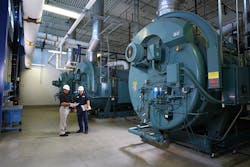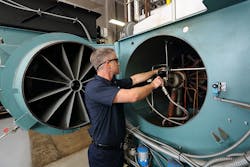Efficiency, sustainability, reliability, safety—these are the keys to the optimal performance of a facility, and they are the focus of a properly conducted boiler-room assessment. This article discusses what goes into a properly conducted boiler-room assessment.
Because it requires a specific methodology and expertise, a boiler-room assessment—for most facilities—is best performed by an outside specialist.
Efficiency
The first step in conducting a boiler-room assessment is to determine facility steam cost. When figuring steam cost, many consider only fuel cost, boiler efficiency, and cold-water makeup. This calculation is “unloaded” because it does not include other costs associated with the production of steam. A “loaded,” or true, cost of steam production includes all of the above plus labor and maintenance, chemicals, and waste charges.
Various terms are applied to efficiency. For instance, combustion efficiency sometimes is used to refer to boiler efficiency, but it really is the ability of a burner to combust fuel with the least amount of excess air without exceeding or compromising acceptable levels of carbon monoxide and safety. Thermal efficiency is overall boiler efficiency before subtracting radiation and convection (R&C) losses. Fuel-to-steam efficiency is the true reflection of how a boiler is performing, as it is net of R&C losses. This is the correct indicator of useful energy going out to a system.
A boiler-room assessor will determine fuel-to-steam efficiency by evaluating the physical condition and features of a boiler’s burner and determine actual efficiency using the procedure outlined in ASME PTC 4-2008, Fired Steam Generators. The procedure takes a number of variables, including stack loss, steam and feedwater flow, moisture in stack gas, and fuel-meter clocking for actual input, into account.
The goal is safe, efficient combustion and optimal heat transfer. To accomplish this, a burner typically will be set at about 3 percent oxygen or 15 percent excess air, which is where it should operate most of the time. For every 2-percent increase in oxygen over the benchmark, there will be a 1-percent loss in efficiency.
The assessor then will observe how well the boiler (heat exchanger) absorbs heat from the burner. If the burner is operating and combusting properly, flue-gas temperature should be approximately 50°F to 100°F above saturated temperature. In other words, if the boiler is operating at 100 lb with a saturation temperature of approximately 340°F, the stack temperature should be between 390°F at low fire and 440°F at high fire. For every 40°F increase over this base point, there will be a 1-percent loss in efficiency.
The assessor also will look for possible climatic variables, including relative humidity in the boiler room, barometric-pressure fluctuations, and ambient air temperature. If ambient temperature changes frequently and the boiler modulates a lot, the system would benefit from an oxygen-trim system, which optimizes combustion controls, keeping the fuel/air ratio consistent.
While taking note of climatic conditions, the assessor will be paying close attention to the burner’s combustion-control system, particularly the modulation frequency. The assessor will look at the turndown capability of the burner, how the burner is tracking the load, and how frequently the burner is cycling.
In addition to the boiler, areas of the boiler room the assessor will evaluate include the exhaust-stack/breeching arrangement and support accessories. Often, a great deal of energy will be lost through the stack. If a boiler is more than 150 hp and is operating at over 100 lb of pressure, some of this energy can be recouped with the addition of an economizer. For every 40°F drop in stack temperature, there will be a 1-percent gain in efficiency.
Next, the assessor will observe how the boiler is set up to control totally dissolved solids in boiler water to maintain proper conductivity. If effluent is going down the drain, a blowdown heat-recovery system, which puts valuable energy into a boiler’s feedwater stream, likely will be recommended.
Other support accessories, along with the amount of condensate coming back from the system, also will be checked. If little is returning and a lot of raw makeup is entering, a carbon filter may be required, if one is not already in place.
The assessor will perform chemical-treatment analysis to determine whether there is a high degree of carbonate/bicarbonate alkalinity. If there is, the addition of a dealkalizer may reduce blowdown and further protect the system. The assessor then will examine the boiler feed system (vented or pressurized), as well as the chemical feed system.
While its primary emphasis will be on boiler-room equipment, a comprehensive assessment will take into account where and how effectively steam is being used. Specifically, the assessor will check piping throughout the plant to see if it is insulated properly. If it is not, valuable energy is being wasted to the process, and the chance of damaging water hammer is heightened.
At the same time, the assessor will look for steam traps. Whether categorized as thermodynamic, mechanical, or thermostatic, all traps serve the same purposes: trap steam, purge air, and evacuate condensate.
Air has a negative effect on processes. It can significantly reduce steam temperature and, thus, heat transfer. When air and other gases enter a steam system, they consume volume steam otherwise would occupy. The temperature of an air-steam mixture is below that of pure steam.
In terms of air elimination, traps can do only so much. Air vents need to be placed in strategic locations to eliminate air or partial-pressure conditions. For example, if a steam line is heating a process load at 86 psig, the temperature of that steam will be 328°F. If air is mixed with the steam, which amounts to 10 percent of the volume, the temperature will drop to 321°F, or the equivalent of 76 psig, even though the steam gauge is registering 86 psig. This extends process time and wastes energy.
An assessor will note how traps are piped, where traps are located, and if the drip pocket is sized correctly with the proper drain valve installed at its bottom.
The assessor will note whether condensate is returning to the boiler room by gravity, shear motive force, or mechanical means. Equally important, the assessor will want to know if condensate is overloading the return system and, thus, is in need of venting; if it is, a surge tank in the boiler room working in conjunction with the existing feed tank likely will be recommended.
Sustainability
Facility owners and managers are seeking ways to conserve natural gas, oil, air, and water. Fresh water not only is an ongoing operational cost, it is becoming scarce, which is one of the reasons returning condensate is so important.
In terms of reducing emissions while improving combustion efficiency, there is an array of high-efficiency, low-emitting burners to dramatically reduce nitrogen-oxide and carbon-monoxide emissions. The assessor will evaluate current systems and recommend additional ways to conserve natural resources and reduce emissions.
If a system has another source of fuel, such as landfill gas or digester gas, that is being wasted (flared off) or hauled away, there are technologies that may be used to burn it.
Reliability
The assessor will thoroughly check the burner, its combustion-control system, and its burner-management system (BMS). It is important a BMS provide all lockout information in a clear and readily understandable way and have the capacity to log and store fault history.
Today’s programmable-logic-controller-based systems integrate not only burners, but all accessory equipment. Integrated systems are important for reliable service and to keep operators informed and able to anticipate and quickly remedy unexpected outages.
An important contributor to reliable boiler operation is an ongoing maintenance program that includes regular combustion analysis. Keep all service records detailing when tune-ups, including efficiency checks, were performed. The assessor will want to review the records. One of the things he or she will look for is elevated stack temperature, which can indicate fireside or waterside fouling. Along with energy loss, elevated stack temperature can seriously damage a boiler.
In addition to service records, the assessor will ask for critical and dynamic records. Critical records include the manufacturer’s data report, equipment documentation, a list of suppliers with contact information, a spare-parts list, operating manuals, wiring diagrams, and standard operating procedures. Dynamic records include startup and tuning reports, repair reports, inspection reports, chemical-analysis reports, and the boiler-room log.
Safety
Properly functioning low-water cutoffs and properly piped safety valves are key safety check points. The assessor will look at steam-line-drip-pocket sizing and location, along with steam-trap location and functionality. Improper sizing, location, and function of steam-line drip pockets and steam traps can cause dangerous water hammer. The main and auxiliary low-water cutoffs and the piping for the boiler’s safety relief valve(s) also will be checked.
Once the assessment is complete, the assessor will review his or her findings with facility management and prepare a report that includes recommendations for the facility going forward. The report likely also will include markups of the plant’s process and instrumentation drawings detailing recommended changes.
Steve Connor is an expert in steam- and hot-water generation with more than 50 years of experience. He recently retired from Cleaver-Brooks as director of technical and marketing services. Randy Smith, PE, CEM, is a sales engineer with Cleaver-Brooks’ Boiler Plant Optimization group, which focuses on improving facilities’ steam generation, distribution, consumption, and condensate return. He has more than 25 years of industrial and boiler-plant experience.
Did you find this article useful? Send comments and suggestions to Executive Editor Scott Arnold at [email protected].











